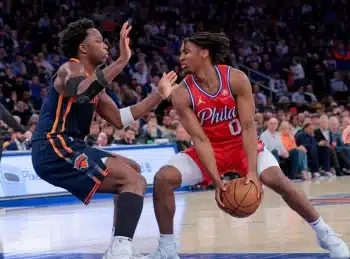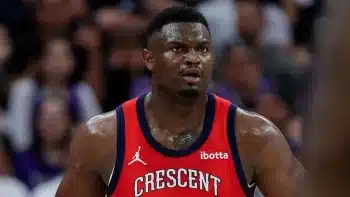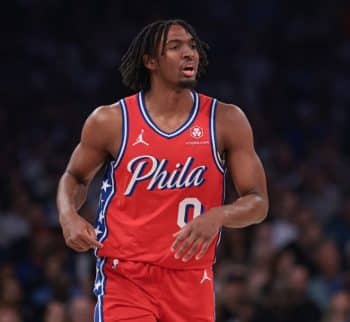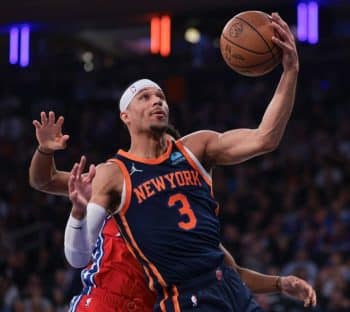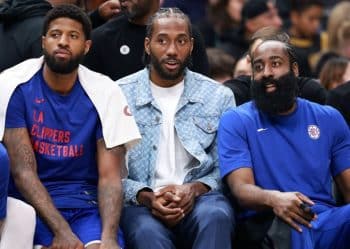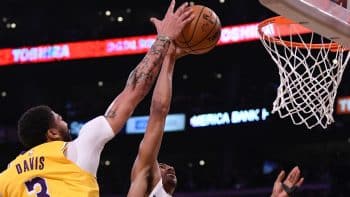NBA
Three Trends About The Cavaliers That Can’t Continue

It’s October 27. The Cleveland Cavaliers are 3-2 with their losses coming to teams that were without key players.
In addition, both of those were played on the second night of a back-to-back against teams that finished in the basement of the Eastern Conference last year.
About a week and a half into the season, there have been a few noticeable trends about this reconstructed Cavaliers squad, so let’s take a look at what’s going on.
1) The Bench Is Outplaying The Starting Five
Before everything started, many people knew how deep Cleveland was going to be. It’s showing already. Contributions from the second unit are paramount to a team’s success, but that should be in addition to what the starters have accomplished, not handling the responsibilities of both groups.
Through five games, the discrepancy between the bench bunch and the starting five has been obvious. Before going further, it’s obvious these guys have to mesh first. This goes double for when Tyronn Lue is trying to figure out who plays best with who and can’t decide on one concrete combination.
LeBron James is playing point guard for the first time *technically* since 2005. J.R. Smith was told at the beginning of the year he’d be coming off the bench and three games in, that changed in an instant. The same goes for Tristan Thompson.
Jae Crowder—who just got moved to the bench—is still learning the tendencies of his new teammates and Kevin Love is in an early-season slump offensively. There’s a lot of mixing and matching going on as Lue attempts to find a combination that clicks. At a stage this early in the year, it’s almost expected to be a work in progress, but it doesn’t excuse laziness and carelessness either. Because of this, they’re coming out of the gates sluggish, putting the team in a hole early from the onset and forcing them to play catch up.
“I don’t know if I can put my hand on it or my foot on it right now, we’d be much better,” James said of the first-quarter slow starts. “It’s just taking us too much time to get into the game, like get into the flow of the game.
“Teams are playing with a faster pace than us to start the game and we have to figure that out for sure.”
On the bright side, it hasn’t taken long for the second unit to develop chemistry between one another. Jeff Green has done everything the Cavaliers have asked of him, running the floor well on fast breaks and using his length to make it tougher on opposing wings to create. Kyle Korver has been the sharpshooter we’re used to seeing, knocking down 52 percent of his three-balls with a simmering 74.5 true shooting percentage to boot.
Iman Shumpert boasts the team’s lowest defensive rating by far (90.6 on/117.2 off) in the 88 minutes he’s played. Channing Frye, though in a much smaller sample size, has Cleveland’s highest offensive rating (137.2 on/104.2 off) since being re-inserted into the rotation. Let’s not forget that Dwyane Wade has only run with these guys for one game as he aims to become Lue’s leader of the second unit.
Facts are facts right now. The eye test tells you and the numbers tell you about the difference between the reserves and the starters. In 98 minutes on the court, the bench has a net rating of +6.8 points per 100 possessions and the second-highest true shooting percentage (61.3) in the NBA behind the Golden State Warriors. They’ve scored over 45 points in four consecutive games and are averaging the fifth-most points overall.
As for the starters, their net rating collectively is a -4.6 per 100 possessions, and a huge contributor to that is the next trend we’ll talk about.
2) The Perimeter Defense: Where Is It?
Cutting to the chase: The Cavaliers are dead last in the NBA in shutting off the three-point line. Their opponents are attempting 36.2 triples per game and converting on 14 of those tries. That’s a sizzling 38.7 percent.
“How many did they make?” a frustrated Lue asked a reporter after a 112-107 loss in Brooklyn. “17.”
That’s been the number that has plagued the team for the past three straight games—yes, three.
“Just not contesting shots,” Lue said. “Like I told you before, these guys are NBA players. We don’t contest shots and get out to the three-point line, they’re going to continue to make them.”
In the two games against the Orlando Magic and Chicago Bulls, you could see the coach’s point. There was absolutely zero resistance for the opposition chucking up long balls. Part of it was due to a faster pace and taking advantage of Cleveland’s older age, but a lot of it could’ve been prevented simply with closing out.
At the very least against the Nets, they put up hands. Many of those shots that Brooklyn hit, especially in the fourth quarter, were just a case of better offense beating out a good defense.
“A lot of ‘em a lot of room, but a lot of ‘em was contested as well,” James said. “We had some that we kind of broke down in the first half, but in the second half we were contesting those threes and they were still bombing ‘em.
“I mean, the one Allen Crabbe made on Kyle [Korver]—a double pump three. He drained it. And the last one Spence [Dinwiddie] hit was pretty deep. But we definitely gotta do that. That’s what this league is now. This league is three-point shots. We’ve gotta get adjusted to that and cover that line.”
3) Missing Good Looks
A huge part of the problem for the offense can be attributed to how poorly the team has shot on wide-open threes. Putting it bluntly, the usual gunners from beyond the arc have been awful.
So far, three out of the top five players with open opportunities are shooting less than 29 percent from deep. Love is the worst culprit of the bunch, as he has had nearly three of those attempts per game to this point and hasn’t come through (28.6 percent). Even on open two-point attempts, Love has disappointed with a lowly 10 percent from the field.
Green and Shumpert have unfortunately followed suit in both the wide-open threes and are shooting less than 25 percent on open two-pointers as well. It’s troubling trend that has not helped the offense as it tries to find an identity.
Clearly, the way to improve on this is to continue to move the ball and look to get easy buckets underneath and live by the ol’ adage of working inside to open up the outside.
Things are almost guaranteed to get better once Derrick Rose returns from his ankle injury, too. As those defenses collapse on him attacking, it’ll open up the perimeter for guys to take advantage and get more chances.
If they keep on getting these looks as the season goes on, they’re going to start hitting them. Eventually, with reps, players like Love especially, will start knocking them down. It’ll only improve as the team’s chemistry grows as well.
The beginning of the year hasn’t been pretty for the Cavaliers. It’s easy to say losing to the Magic and Nets was laughable, but when you look at how both of those teams have operated in the infancy of the season, it’s not all that surprising.
They’re young and hungry ball clubs who have been playing fast and hitting their shots. Couple that with an older, veteran-heavy squad traveling to play its second game in 48 hours and there’s a good chance to catch them sleepwalking.
Cleveland is going to be just fine. The road has been bumpy so far as it has been in multiple past seasons. It’s going to be full of ups and downs, but in the end, the team with LeBron always seems to figure it out.
